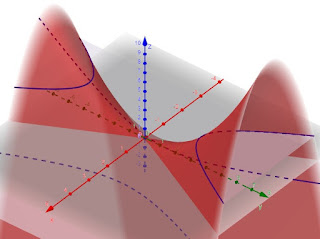- 'slice' the surface horizontally using planes
, we get hyperbola shapes (the leftmost graph below). Take note at z = 0, we get a cross, 'x'. z = 0 serves as a threshold whether the direction of hyperbola opening changes its direction.
- 'slice' the surface vertically using planes
, we get parabola shapes (the middle graph below);
- 'slice' the surface vertically using plane x = 0, we get a parabola (the rightmost graph below). Even if you 'slice' the surface vertically with
, you will still get parabolas. To avoid the graph looks too 'crowded', I only use one plane to 'slice' the surface.
 |
 |
 |
You may change the values of a, b and c to see the changes of the graph. Type 1 is the first equation stated on top of this article, Type 2 is the second and Type 3 refers to the third equation. Please un-tick all choices before you change to another type of equation. You may click here if you want to have better viewing experience.
If the surface is shifted to be centered at (h, k, l), then the equations above will look like the equations below:
You may refer to other quadric surfaces on the surface shifting concept. It applies the same here.
No comments:
Post a Comment